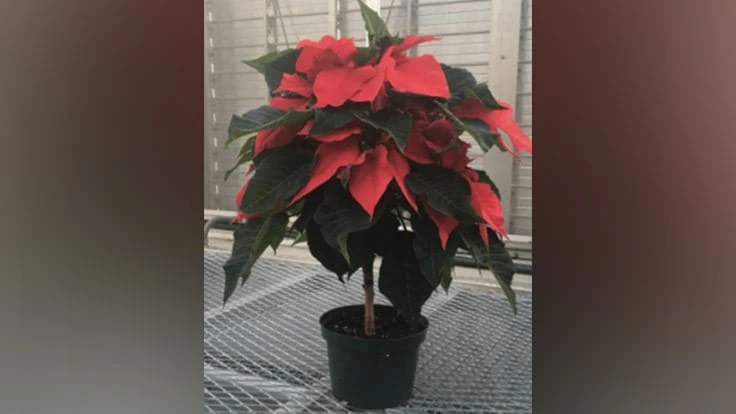

The heart of bedding plant season isn’t a time when growers traditionally need to think about planting poinsettias. However, it is the time to start thinking about growing poinsettias in a tree form. Poinsettia trees are certainly not a mass-market, bench-run crop. But trees are a unique form of poinsettia that add variety to any product line; plus they’re eye-catching. While growing poinsettia trees isn’t as well-defined as a single, pinched poinsettia in a 6-inch container, this article will review the key points for producing them.
Cultivar selection
Just like any other form of poinsettia, cultivar selection is an important part of producing the right finished poinsettia trees. Branch strength is an important characteristic for cultivars used to produce tree forms. Since the canopies can get large, strong branches are a necessity. This is especially true for large trees. Bract sizes vary among poinsettia cultivars, and large-bracted cultivars are best-suited to large trees, whereas cultivars with smaller bracts can be appropriate for small trees. Similarly, vigorous cultivars are better-suited for large trees and less-vigorous cultivars should be reserved for small trees.
Container size and spacing
The container size is directly related to the finished height of poinsettia trees. Trees finishing between 18 and 22 inches finish in 6- or 6.5-inch containers. For taller trees, use taller containers. Large trees are typically not finished in the same container they were started in. For example, 3- or 4-foot trees may finish in a 12-inch container, but they start in a 5- or 6-inch containers. Do not plant rooted cuttings directly into large containers. Rather, transplant the 5- or 6-inch containers into large containers after the plants are established. Containers can be spaced “pot-to-pot” early in production. As poinsettia trees grow, they should be provided with more space, since stems need to be strong, not spindly. Once the canopy is starting to develop is when trees will require the most growing space, allowing ample room for branch development.
Developing the trunk
The most characteristic part of a poinsettia tree is the tall stem or “trunk.” The first step to developing a sufficient trunk is to start the crop earlier than more traditional poinsettia forms. The taller the target finished height, the earlier cuttings must be planted. For example, some of the large tree forms need to be planted in late May or early June, while smaller tree sizes can be planted later. By planting early, you leave enough time before pinching allows for the development of the tall stem. However, sometimes stem elongation needs to be promoted.
If early planting date and cultivar vigor are not resulting in sufficient stem growth, plant growth regulators can be used to promote stem elongation. Foliar spray applications of commercial gibberellic acid (GA3) products such as Florgib or ProGibb are the most useful products for promoting stem elongation. Concentrations of GA3 between 50 and 100 ppm are most effective at promoting elongation.

Pruning, leaf removal and pinching
Trees require a few more steps to produce and maintain well-formed plants. At different times during production, branches are removed to form and maintain the single-stemmed trunk, followed by pinching to promote the canopy, and then leaf removal to make the “trunk” appear.
To maintain the single-stem trunk and promote stem elongation, axillary branches should be removed throughout production. Side branches should be removed when they are between 1 to 2 inches long; detaching when they are any shorter may prevent complete branch removal and result in just removing leaves. Alternatively, if branches are taken off when they are longer than 2 inches, there is a more potential for damaging the plants.
Pinching promotes branching, and the number and timing of pinches influences how the “canopy” of the poinsettia tree is formed. For tabletop trees, traditional tree schedules recommend two pinches, one in mid-August and the second in mid-September. A single pinch, though, about two weeks before the start of short days can also produce attractive plants and shorten the schedule. Large trees will need two or three pinches over the course of production to produce a well-shaped and full canopy. Regardless of which approach is taken, the last pinch for either two- or three-pinch trees should be completed by mid-September.
While the single stem is being developed into a trunk, do not remove the leaves, as leaving them will help increase trunk caliper and strength. About four weeks after the start of short days, leaves can be removed from the main stem, usually in late September for large trees or October for smaller ones, based on a natural day length for flowering. By keeping leaves on the stem until this point, the caliper of the trunk will increase and make it stronger. Leaves can be removed by hand, but care should be taken to not damage stems. Alternatively, leaves can be cut off to leave about half an inch of the petiole attached to the stem, after which they will dry up and fall off without risk of wounding the plant.
Take-home
Poinsettia trees are a unique form that can range from simpler tabletop versions to plants 4 feet and taller. The fundamental processes for producing tree forms don’t change with different finished sizes, but the timing does.

Explore the June 2020 Issue
Check out more from this issue and find your next story to read.
Latest from Greenhouse Management
- Anthura acquires Bromelia assets from Corn. Bak in Netherlands
- Top 10 stories for National Poinsettia Day
- Langendoen Mechanical hosts open house to showcase new greenhouse build
- Conor Foy joins EHR's national sales team
- Pantone announces its 2026 Color of the Year
- Syngenta granted federal registration for Trefinti nematicide/fungicide in ornamental market
- A legacy of influence
- HILA 2025 video highlights: John Gaydos of Proven Winners





